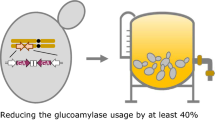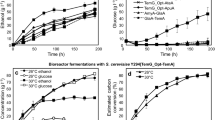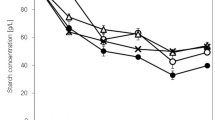Abstract
Industrial strains of a polyploid, distiller’s Saccharomyces cerevisiae that produces glucoamylase and α-amylase was used for the direct fermentation of raw starch to ethanol. Strains contained either Aspergillus awamori glucoamylase gene (GA1), Debaryomyces occidentalis glucoamylase gene (GAM1) or D. occidentalis α-amylase gene (AMY), singly or in combination, integrated into their chromosomes. The strain expressing both GA1 and AMY generated 10.3% (v/v) ethanol (80.9 g l−1) from 20% (w/v) raw corn starch after 6 days of fermentation, and decreased the raw starch content to 21% of the initial concentration.


Similar content being viewed by others
References
de Moraes LMP, Astolfi-filho S, Oliver SG (1995) Development of yeast strains for the efficient utilization of starch: evaluation of constructs that express α-amylase and glucoamylase separately or as bifunctional fusion proteins. Appl Microbiol Biotechnol 43:1067–1076
Eksteen JM, van Renseburg P, Cordero Otero RR, Pretorius IS (2003) Starch fermentation by recombinant Saccharomyces cerevisiae strains expressing the α-amylase and glucoamylase genes from Lipomyces kononenkoae and Saccharomycopsis fibuligera. Biotechnol Bioeng 84:639–646
Ghang DM, Yu L, Lim MH, Ko HM, Im SY, Lee HB, Bai S (2007) Efficient one-step starch utilization by industrial strains of Saccharomyces cerevisiae expressing the glucoamylase and α-amylase genes from Debaryomyces occidentalis. Biotechnol Lett 29:1203–1208
Gietz D, St Jean A, Woods R, Schiestl RH (1992) Improved method for high efficiency transformation of intact yeast cells. Nucleic Acids Res 20:1425
Janse BJ, Pretorius IS (1995) One-step enzymatic hydrolysis of starch using a recombinant strain of Saccharomyces cerevisiae producing α-amylase, glucoamylase and pullulanase. Appl Microbiol Biotechnol 42:876–883
Kim JH, Kim HR, Lim MH, Ko HM, Chin JE, Lee HB, Kim IC, Bai S (2010) Construction of a direct starch-fermenting industrial strain of Saccharomyces cerevisiae producing glucoamylase, α-amylase and debranching enzyme. Biotechnol Lett 32:713–719
Lee FWF, Da Silva NA (1997) Improved efficiency and stability of multiple cloned gene insertions at the δ sequences of Saccharomyces cerevisiae. Appl Microbiol Biotechnol 48:339–345
Lin LL, Ma YJ, Chien HR, Hsu WH (1998) Construction of an amylolytic yeast by multiple integration of the Aspergillus awamori glucoamylase gene into a Saccharomyces cerevisiae chromosome. Enzyme Microb Technol 23:360–365
Ma Y, Lin LL, Chien HR, Hsu WH (2000) Efficient utilization of starch by a recombinant strain of Saccharomyces cerevisiae producing glucoamylase and isoamylase. Biotechnol Appl Biochem 31:55–59
Marin D, Jimenez A, Lobato MF (2001) Construction of an efficient amylolytic industrial yeast strain containing DNA exclusively derived from yeast. FEMS Microbiol Lett 201:249–253
Ness F, Lavallee F, Dubourdieu D, Aigle M, Dulau L (1993) Identification of yeast strains using the polymerase chain reaction. J Sci Food Agric 62:89–94
Nieto A, Prieto JA, Sanz P (1999) Stable high-copy number integration of Aspergillus orizae α-amylase cDNA in an industrial baker’s yeast strain. Biotechnol Prog 15:459–466
Sambrook J, Russell DW (2001) Molecular cloning: a laboratory manual. Cold Spring Harbor Laboratory Press, Cold Spring Harbor
Shigechi H, Koh J, Fujita Y, Matsumoto T, Bito Y, Ueda M, Satoh E, Fukuda H, Kondo A (2004) Direct production of ethanol from raw corn starch via fermentation by use of a novel surface-engineered yeast strain codisplaying glucoamylase and α-amylase. Appl Environ Microbiol 70:5037–5040
Sun H, Zhao P, Ge X, Xia Y, Hao Z, Liu J, Peng M (2010) Recent advances in microbial raw starch degrading enzymes. Appl Biochem Biotechnol 160:988–1003
Yamada R, Bito Y, Adachi T, Tanaka T, Ogino C, Fukuda H, Kondo A (2009) Efficient production of ethanol from raw starch by a mated diploid Saccharomyces cerevisiae with integrated α-amylase and glucoamylase genes. Enzyme Microb Technol 44:344–349
Yamada R, Tanaka T, Ogino C, Fukuda H, Kondo A (2010) Novel strategy for yeast construction using δ-integration and cell fusion to efficiently produce ethanol from raw starch. Appl Microbiol Biotechnol 85:1491–1498
Acknowledgments
This work was supported by a grant of the Korea Ministry of Education, Science and Technology (The Regional Core Research Program/Biohousing Research Institute). Ha-Ram Kim and Young-Kum Im were supported by the second stage of the Brain Korea 21 project.
Author information
Authors and Affiliations
Corresponding author
Rights and permissions
About this article
Cite this article
Kim, HR., Im, YK., Ko, HM. et al. Raw starch fermentation to ethanol by an industrial distiller’s yeast strain of Saccharomyces cerevisiae expressing glucoamylase and α-amylase genes. Biotechnol Lett 33, 1643–1648 (2011). https://doi.org/10.1007/s10529-011-0613-9
Received:
Accepted:
Published:
Issue Date:
DOI: https://doi.org/10.1007/s10529-011-0613-9




